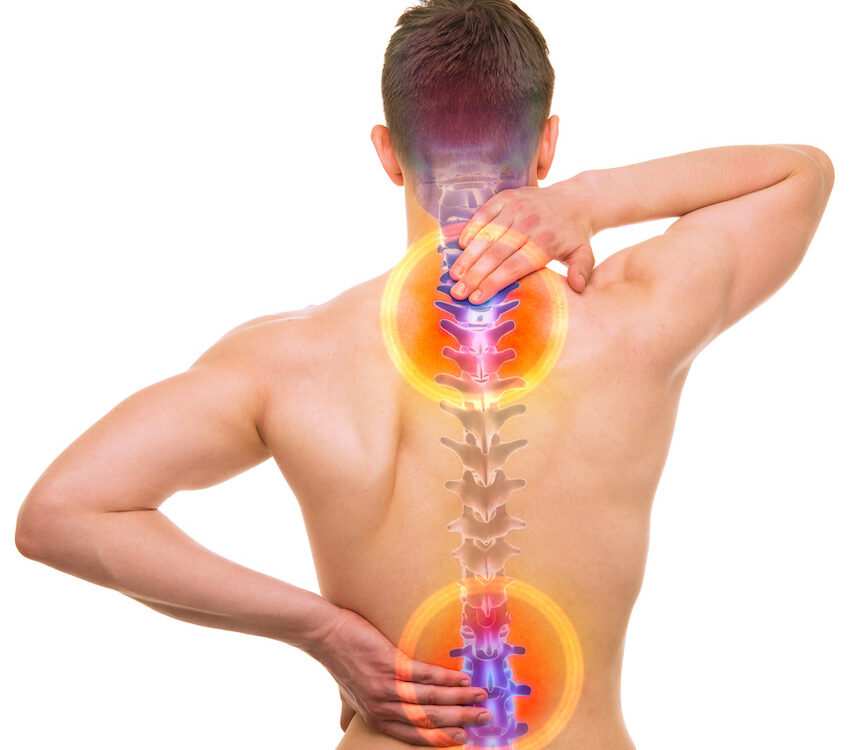
Neck Pain
Neck pain is a common condition affecting millions of Americans.
Most episodes of neck pain are due to muscle strain or soft tissue sprain (ligaments, tendons), but it can also be caused by a sudden force (whiplash). Most neck pain improves with time and non-surgical care such as medication, physical therapy and chiropractic manipulation. However, should the neck pain continue or worsen, there is likely a specific condition that requires targeted treatment, such as cervical degenerative disc disease, cervical herniated disc, cervical stenosis, or cervical arthritis.
Causes & Symptoms
Typical sources of neck pain include:
- The large nerve roots in the neck that go to the arms may be irritated.
- The smaller nerves that supply the neck may be irritated.
- The large cervical muscles may be strained.
- The bones, ligaments or joints may be damaged.
- An intervertebral disc may be degenerating.
Common symptoms associated with neck pain usually involves one or more of the following:
- Stiff neck. Soreness and difficulty moving the neck, especially when trying to turn the head from side to side.
- Sharp pain. This symptom can be pain localized to one spot and might feel like it’s stabbing or stinging. Often, this type of pain occurs in the lower levels of the neck.
- General soreness. The pain is mostly in one spot or area on the neck, and it’s described as tender or achy, not sharp.
- Radiating pain. The pain can radiate along a nerve from the neck into the shoulders and arms. The intensity can vary and this nerve pain might feel like it’s burning or searing.
- Tingling, numbness, or weakness. These sensations can go beyond the neck and radiate into the shoulder, arm or finger. There could be a “pins-and-needles” sensation. Typically, pain that radiates down the arm is felt in only one arm, not both.
- Trouble with gripping or lifting objects. This can happen if tingling, numbness, or weakness in the fingers is present.
- Headaches. Sometimes an irritation in the neck can also affect muscles and nerves connected to the head. This could be a tension headache, such as from neck muscles tightening; or occipital neuralgia, where a pinched occipital nerve in the neck causes pain to radiate up into the head’s sides and scalp.
To watch a video about neck strains, click here:
http://www.spine-health.com/video/neck-strains-and-sprains-video
Neck pain is considered chronic when it persists for more than 3 months. These conditions tend to stem from problems in the cervical spine either with a facet joint or disc. Common causes include:
- Cervical degenerative disc disease.
- Natural wear and tear occurs in the neck over time. It’s normal for the discs to gradually lose hydration and the ability to cushion the spine’s vertebrae.
- However, should a disc degenerate significantly, it can lead to painful irritation of a cervical nerve, such as a herniated disc, pinched nerve, or changes in the facet joints that lead to arthritis.
To watch a video about cervical degenerative disc disease click here:
http://www.spine-health.com/conditions/degenerative-disc-disease/cervical-degenerative-disc-disease
Cervical herniated disc
A cervical disc is herniated when its inner layer, the nucleus pulposus, leaks out through a tear in the disc’s protective outer layer. This typically results from an injury.
A herniated disc may press against or pinch a cervical nerve, precipitating pain signals due to inflammation.
Cervical osteoarthritis
When the cartilage in a cervical facet joint wears down enough, it can lead to cervical osteoarthritis, also known as cervical spondylosis. Rather than having the facet joints move smoothly along cartilage as intended, they might grind bone on bone. The joint could become enlarged from inflammation and bone spur growth, causing a nearby nerve to become pinched or pressed.
Cervical spinal stenosis with myelopathy
Spinal stenosis occurs when the spine’s degeneration leads to a narrowing of the spinal canal, such as from a herniated disc. When the spinal canal narrows enough to compress the spinal cord, a condition known as myelopathy can result. Myelopathy is when compression of the spinal cord causes secondary symptoms, such as weakness, in the arms, hands, legs, or feet.
Cervical foraminal stenosis
Each vertebral body contains foramen; these are holes in the bone through which nerve branches exit the spinal canal. Foraminal stenosis occurs when these foramina become narrowed, causing nerve irritation and inflammation. Foraminal stenosis is associated with radiating, or radicular, pain that manifests along the nerve roots path.
If a cervical nerve root gets irritated or compressed, such as by a herniated disc or bone spur, the condition will be described as a cervical radiculopathy. Cervical radiculopathy, or radicular pain, simply means that the cervical nerve has been irritated and is causing symptoms to radiate along the path of the nerve, such as from the neck into the shoulders, arms, and fingers.
As discussed, these individual nerves are associated with a specific area of sensation, a specific reflex, and a specific muscle function. Based on the pattern of numbness, reflex changes, and specific muscle weakness, Restore Medical Partners physicians can often predict which nerve is being pinched before confirming with diagnostic studies.
To learn more about cervical radiculopathy watch this video:
http://www.spine-health.com/conditions/neck-pain/what-cervical-radiculopathy
The causes of neck pain can be complex, and there are many structures in the spine that can cause pain. The first line of treatment for neck pain includes:
- Pain-relieving medications such as acetaminophen, ibuprofen, muscle relaxants, or prescription medications.
- Physical therapy and exercise helps strengthen the neck to avoid future injury and speed the recovery process.
- Lifestyle adjustments to avoid aggravating movements.
- Alternative therapies such as massage, yoga, and acupuncture may provide benefit to some patients
At Restore Medical Partners, we will ask patients to describe the location, severity and type of pain, in addition to the history of the pain: when the patient started to feel it, and any activities or positions that make the pain better or worse. We will review your MRI or order imaging if you do not have imaging completed on your first visit. Then, we will explain to you what is causing your neck pain. Our goal is to prevent major surgery and use minor interventional techniques to relieve your pain and get you back to doing the things you enjoy. For arthritis pain, we may recommend radio frequency ablation. For a disc herniation causing foramina stenosis or radiculopathy, we may recommend an epidural steroid injection. For muscle spasm, we may recommend trigger point injections into the muscles. Some patients may require a combination of techniques to completely resolve their pain symptoms.
To learn more about what a cervical epidural steroid is click here:
http://www.spine-health.com/video/cervical-epidural-steroid-injection-video
REFERENCES:
http://www.spine-health.com/conditions/neck-pain/neck-pain-symptoms



